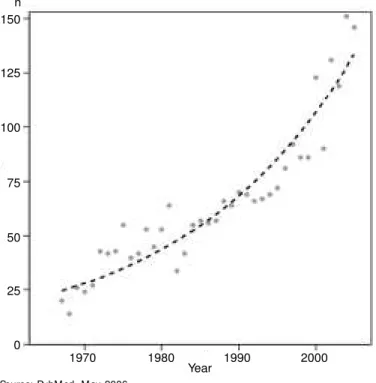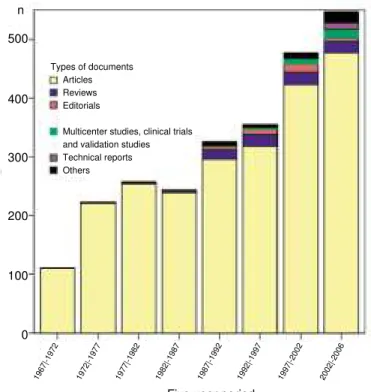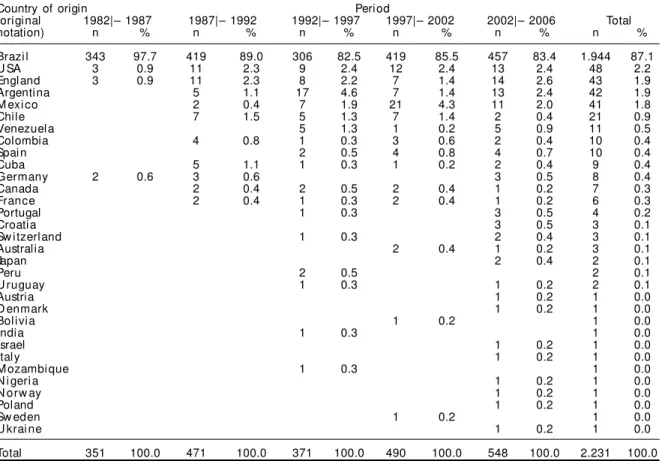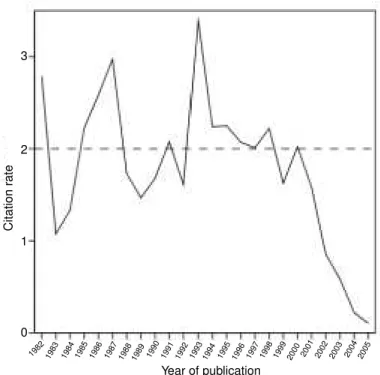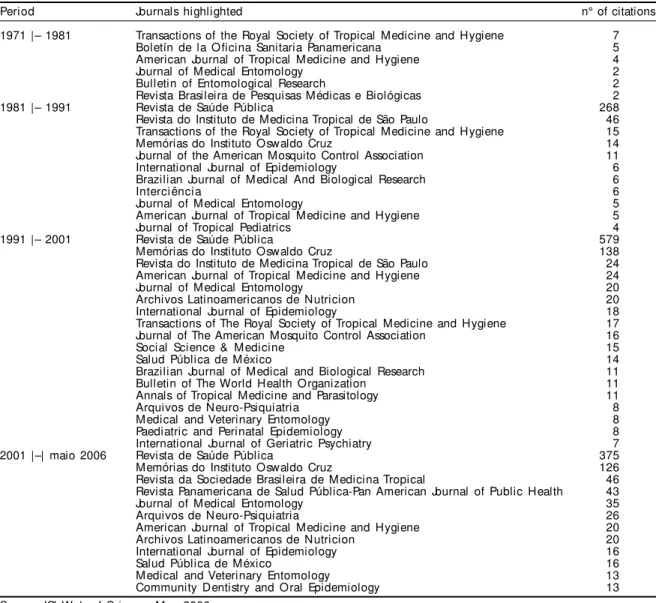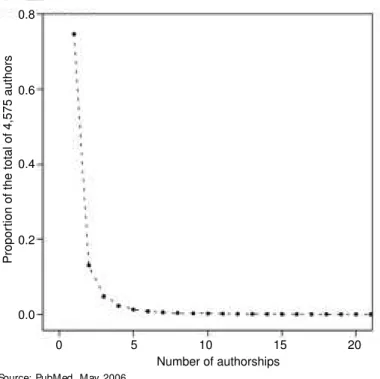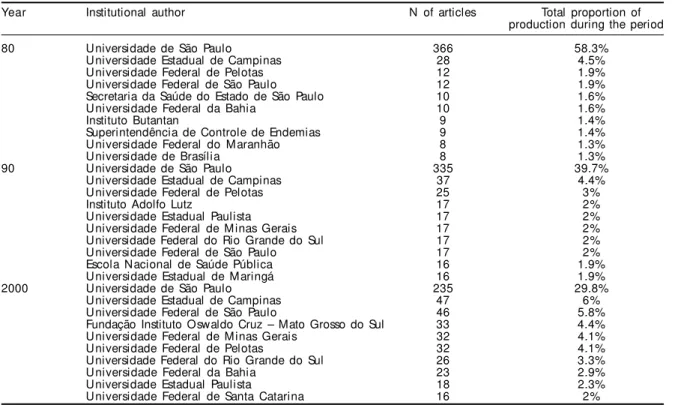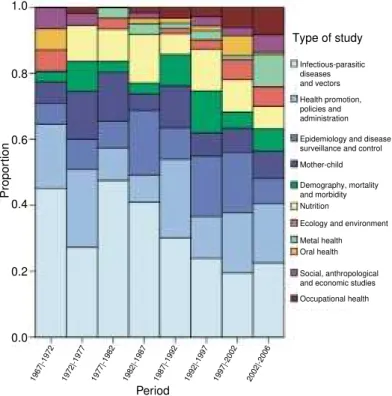Revista de Saúde Pública:
forty years of Brazilian
scientific production
ABSTRACT
OBJECTIVE: To recognize the characteristics and path taken by the through analysis of the scientific production it has published over the period from 1967 to 2005.
METHODS: Scientometric methods were used to analyze reference data on the articles published in the Revista, retrieved from the databases ISI/Thomson Scientific (Web of Science), National Library of Medicine (PubMed) and Scientific Electronic Library Online (SciELO).
RESULTS: The Revista is the only Brazilian publication in the field of public health that is indexed by ISI/Thomson Scientific. It is prominent as a medium for publishing Brazilian scientific production in public health and is displaying a geometric increase in publication and citation, with annual rates of 4.4% and 12.7%, respectively. The mean number of authors per paper has risen from 2 to 3.5 over recent years. Although original research articles predominate, the numbers of reviews, multicenter studies, clinical trials and validation studies have been increasing. The number of articles published in foreign languages has also increased, accounting for 13% of the total, and the leading countries originating these are the UK, USA, Argentina and Mexico. The number and diversity of journals citing the Journal has been increasing, many of which are non-Brazilian. Authorship per author shows good fit to Lotka’s Law, but the parameters suggest greater concentration and less dispersion than would be expected. Among the fields of interest of published papers, the following topics account for more than 50% of the total volume: infectious-parasitic diseases and vectors; health promotion, policies and administration; and epidemiology, surveillance and disease control.
CONCLUSIONS: The Revista shows great dynamism, without signs of abating or reaching a plateau any time soon. There are signs of progressively increasing complexity in the studies published, and more multidisciplinary work. The Revista seems to be widening its outreach and recognition, while remaining faithful to the field of public health in Brazil.
KEYW O RD S: Scientific publications. Periodicals, history. Periodicals, trends. Public health.
Júlio Cesar Rodrigues Pereira
Departamento de Epidemiologia. Faculdade de Saúde Pública. Universidade de São Paulo. São Paulo, SP, Brasil
Correspondence:
Júlio Cesar Rodrigues Pereira
Departamento de Epidemiologia - FSP/USP Av. Dr. Arnaldo, 715
Figure 1 - Scatter plot for the numbers of articles by the Revista de Saúde Pública, by year of publication for the period from 1967 to 2005, and curve fitted to the data.
Source: PubMed, May 2006
Year 1990 2000
1980 1970
100
75 n
50
25
0 150
125
INTRODUCTION
The Revista de Saúde Pública is reaching its
fortieth anniversary distinguished as one of the leading journals in the field of public health in Brazil. In fact, preliminary analysis of the data from the project “Characteriza-tion of Postgraduate Programs in Public Health in Brazil”,* in which all the scien-tific production from postgraduate lecturers within this field that is registered in the Thomson Scientific database (formerly ISI, the Institute for Scientific Information) up to 2005 is being studied, places the Revista
as the first choice for the publication of their work. In this analysis, it has been seen that, with regard to indexed journals in that data-base, these authors concentrate the publica-tion of their work in seven journals, which alone account for one-third of the produc-tion from this group of authors:
1° Revista de Saúde Pública, with 939 articles;
2° Memórias do Instituto Oswaldo Cruz, with 163 articles;
3° Brazilian Journal of Medical and Biological Research, with 145 articles;
4° American Journal of Epidemiology, with 128 articles;
5° Journal of Dental Research, with 127 articles; 6° Transactions of the Royal Society of Tropical
Medicine and Hygiene, with 57 articles; 7° Circulation, with 56 articles.
This group of journals has been identified as the hard core of publications from postgraduate lecturers in public health, by applying Bradford’s Law.1 This pre-dicts that, among the set of publications within a sci-entific discipline, the numbers of journals in the first, second and third terciles of production obey an order of 1:n:n2. The records in the aforementioned project include 4,842 publications and the Bradford sets have been identified in a ratio that is close to the theoreti-cal prediction: 1:n:n1.8.
Bradford’s theory was among the first contributions towards originating scientometry, a scientific disci-pline that is well established today. From the middle of last century onwards, it became greatly boosted through procedures for bibliometric analysis, thanks to the consolidation of the records relating to scien-tific production, on a regular basis. In the present article, bibliometric records are analyzed with a view to offering a portrait of the scientometric base for these forty years of the Revista de Saúde Pública.
M ETH O D S
The Revista has had its publications registered in the
MEDLINE database of the National Library of Medi-cine, in the United States, since 1967; in the Social Science Citation Index and the Web of Science, since 1982; and in SciELO (Scientific Electronic Library Online), an initiative coordinated by BIREME-PAHO/ WHO (Latin American and Caribbean Center on Health Sciences Information) and by the Fundação
de Amparo à Pesquisa do Estado de São Paulo (Fapesp
-State of São Paulo Research Foundation), since 1977. On the basis of the records in the Web of Science, MEDLINE/PubMed and SciELO, it was sought to characterize the Revista over the period from 1967 to 2005, according to the patterns of:
1) production, through studying the publication dynamics and characteristics of the articles over this period;
2) reach and repercussion, through studying their citations;
3) authorship, through fitting this to scientometric laws and by institutional authorship; and 4) topics of interest, through analyzing keywords.
Details of the methodological procedures for the analysis will be presented together with the results from each of these databases. The methodological description will be restricted to what is necessary for
Articles Reviews Editorials
Multicenter studies, clinical trials and validation studies Technical reports Others Types of documents 500
400
300
200
100
0 n
Five-year period
1967|-1972 1972|-1977 1977|-1982 1982|-1987 1987|-1992 1992|-1997 1997|-2002 2002|-2006
Figure 2 - Types of documents published in the Revista de Saúde Pública, by five-year period between 1967 and 2005.*
*ISI/Thomson Scientific (Web of Science), M ay/2006. The most recent five-year period is incomplete, only covering four years
correct interpretation of the results and as required for clarifying their presentation.
RESU LTS
Production
It is the MEDLINE/PubMed databases that gather together the greatest quantity of in-formation on the articles published by the
Revista: there are records of 2,540 documents
of different types, of which 20 were in 1967 and 146 were in 2005. Figure 1 shows the scatter of the annual numbers of items pub-lished over this period, and also a curve fit-ted using the least-squares method as a sug-gestion for the inferred behavioral pattern.
The curve suggested in Figure 1 has a good fit (R2=0.89) and is described by the follow-ing function:
in which the parameters indicate, respec-tively:
• 24.64: The Revista started by publishing around 25 articles per year;
• 0.044: It has been growing geometrically at a mean rate of 4.4% per year; • 1967: The initial year was 1967, i.e. the
counting of time started with that year (t0=1967)
According to the classification by types of publication in the PubMed database, scien-tific articles account for 92% of all types of documents published, but by examining the trends, it can be seen that, over more recent five-year periods, other types have progres-sively gained space in the Revista (Figure 2).
For the same period, the PubMed records also make it apparent that, despite the predomi-nance of the Portuguese language (87% of the total), both Spanish and English have been increasing the participation over recent years, as shown by Figure 3. It should be noted that, in its electronic format, the
Revista has also been published in the
Eng-lish language since 2003.
In the Web of Science records, the countries of origin of the authors of documents
pub-0,044 (ano - 1967)
n = 24,64.e (1)
Figure 3 - Languages* of the articles published by the Revista de Saúde Pública, by five-year period between 1967 and 2005.**
*From 2003 onw ards, the Journal also started to be published in English in its electronic version.
**ISI/Thomson Scientific (Web of Science), M ay/2006. The most recent five-year period is incomplete, only covering four years.
Languages Portuguese English Spanish
Five-year period
1967|-1972 1972|-1977 1977|-1982 1982|-1987 1987|-1992 1992|-1997 1997|-2002 2002|-2006
500
400
300
200
100
Table 2 - Reproduction of the impact measurements for the Revista de Saúde Pública presented by the Essential Science Indicators of the ISI/Thomson Scientific database, May 2006.
Citation data
in 5-year intervals 1996-2000 1997-2001 1998-2002 1999-2003 2000-2004 2001-2005 2002-2006
# of papers 427 441 456 486 539 581 636
Times cited 173 203 216 268 323 387 350
Citations per paper 0.40 0.46 0.47 0.55 0.59 0.66 0.55
lished by the Revista can be ascertained. Over the period from 1982 to 2005, there were a total of 2,241 publications, of which 2,231 have valid records of their country of origin. By dividing this period into five-year periods, the information presented in Table 1 is obtained. Similar information can also be ob-tained from SciELO for the period 1997-2005, but preference was given to the Web of Science because of its broader coverage.
Reach and repercussion
Also from the Web of Science records, the behavioral patterns of citations of articles published by the
Revista can be ascertained. Among the 593 journals
in the field of “General Social Sciences”, within which
the Revista de Saúde Pública is indexed, it is ranked
238th in numbers of citations, although it is 577th in numbers of citations per article. These statistics
re-Table 1 - Country of origin of the publications in the Revista de Saúde Pública, according to the periods indicated, from the ISI records.*
Country of origin Period
(original 1982|– 1987 1987|– 1992 1992|– 1997 1997|– 2002 2002|– 2006 Total
notation) n % n % n % n % n % n %
Brazi l 343 97.7 419 89.0 306 82.5 419 85.5 457 83.4 1.944 87.1
U SA 3 0.9 11 2.3 9 2.4 12 2.4 13 2.4 48 2.2
Engl and 3 0.9 11 2.3 8 2.2 7 1.4 14 2.6 43 1.9
Argentina 5 1.1 17 4.6 7 1.4 13 2.4 42 1.9
M exi co 2 0.4 7 1.9 21 4.3 11 2.0 41 1.8
Chile 7 1.5 5 1.3 7 1.4 2 0.4 21 0.9
Venezuel a 5 1.3 1 0.2 5 0.9 11 0.5
Colombia 4 0.8 1 0.3 3 0.6 2 0.4 10 0.4
Spai n 2 0.5 4 0.8 4 0.7 10 0.4
Cuba 5 1.1 1 0.3 1 0.2 2 0.4 9 0.4
Germany 2 0.6 3 0.6 3 0.5 8 0.4
Canada 2 0.4 2 0.5 2 0.4 1 0.2 7 0.3
France 2 0.4 1 0.3 2 0.4 1 0.2 6 0.3
Portugal 1 0.3 3 0.5 4 0.2
Croatia 3 0.5 3 0.1
Sw i tzerl and 1 0.3 2 0.4 3 0.1
Australia 2 0.4 1 0.2 3 0.1
Japan 2 0.4 2 0.1
Peru 2 0.5 2 0.1
U ruguay 1 0.3 1 0.2 2 0.1
Austria 1 0.2 1 0.0
D enmark 1 0.2 1 0.0
Bol i vi a 1 0.2 1 0.0
India 1 0.3 1 0.0
Israel 1 0.2 1 0.0
Ital y 1 0.2 1 0.0
M ozambique 1 0.3 1 0.0
N i geri a 1 0.2 1 0.0
N orw ay 1 0.2 1 0.0
Poland 1 0.2 1 0.0
Sw eden 1 0.2 1 0.0
U krai ne 1 0.2 1 0.0
Total 351 100.0 471 100.0 371 100.0 490 100.0 548 100.0 2.231 100.0
*ISI/Thomson Scientific (Web of Science), May/2006
late to May 2006 and are available under the head-ing “Essential Science Indicators”, in which data re-lating to the previous ten years plus the current year are analyzed, with updating every two months. The Web of Science presents information processed as five-year periods, as shown by the data in Table 2.
An examination of the annual citation rates for the articles published since 1982 suggests a tendency towards each article resulting in two citations, as shown in Figure 4.
Recently, with the implementation of the “Essential Science Indicators”, the ISI/ Thomson Scientific database has restricted the calculation of the impact factor (number of citations of the articles published over the last two-year period divided by the number of articles published during this two-year period) to the so-called Science Edition of the Journal Citation Reports (JCR). Until then, the impact factor for journals in the Web of Science - Social Sciences database appeared in the JCR, and the Revista de
Saúde Pública registered an impact factor
of around 0.35 citations per article.
However, the impact factor for the Revista
can be gauged from the SciELO database, which was implemented with pioneering participation from the Revista. There, in a consultation in May 2006, the current im-pact factor found was 0.1038, using a two-year calculation basis, and 0.1333, for a three-year basis. Taking the two-year impact factors in a historical series, figures ranging from 0.2 to 0.4 were found. It was noted that, although the impact rates originated from different data collections, they converged
towards similar figures, thereby suggesting the strong inductive inference that this is a fair measurement of
the Revista’s performance.
In SciELO, in the same way as previously done by JCR, there is the additional information of calcula-tions of the half-lives of citacalcula-tions (the time taken for 50% of the total number of citations to occur, or the median of the age of the citations). At present, the half-life is 6.38 and, from examination of the historical series, it was observed that it ranged from four to eight years. Again, this information is consistent with the citations register in the Web of Science, which was analyzed in Figure 4, and this suggests that after around ten years, all the citations ex-pected have been concluded.
In addition to now offering statistics on 158 indexed journals with the same quality as in the Web of Science, SciELO also offers free access to each of them in digital files. Any edition of the Revista de Saúde Pública can be freely consulted, from 1977 up to the present date, and PubMed offers a link for such consultations. This, together with the grow-ing share of articles in the English language (Figure 3), establishes the conditions needed for an increase in its reach and progressive growth in its citations. Just as in the produc-tion, the numbers of citations have also grown exponentially, as suggested by Figure 5. Figure 4 - Annual ci tati on rate* for the Revi sta de Saúde Públ i ca, according to records from ISI/Thomson Scientific, 1982 to 2005.
*Number of citations / Number of articles published, ISI/Thomson Scientific (Web of Science), May 2006
Citation r
ate
3
2
1
0
1982 1983 1984 1985 1986 1987 1988 1989 1990 1991 1992 1993 1994 1995 1996 1997 1998 1999 2000 2001 2002 2003 2004 2005
Year of publication
Figure 5 - Numbers of citations of the Revista de Saúde Pública, by year of occurrence of the citation, and curve fitted to the data.
Source: ISI/Thomson Scientific (Web-of-Science), May 2006
Number of citations
400
300
200
100
0
Year of citation
1970 1980 1990 2000 2010
1
) ( = α+
α αβ
x x f
a
x c x f( )=
By fitting the function suggested by Figure 5 to the data (note that 2006, which is still incomplete, has been disregarded because it is aberrant), an excellent fit is obtained (R2 = 0.97) for an exponential function of the following form:
in which the parameters, as in the case of the produc-tion, indicate respectively:
• 5.52: The Revista started with around f ive citations per year;
• 0.127: The numbers have been increasing geometrically at a mean rate of 12.7% per year; • 1971: The Revista started to be cited in 1971.
It is worth noting that the growth rate for citations is more than twice the growth rate for production. This suggests that, in addition to vegetative growth re-sulting only from the increase in the numbers of cles published and their citation yield (two per arti-cle published), the growth in citations can be attrib-uted to other factors. Among the candidates for such explanatory variables are both the progressive in-crease in texts in English and the greater ease of ac-cess provided by SciELO.
The sources of citation of the Revista today differ from those of its early years. The first five-year pe-riod with records in the Web of Science (1982-1986) allows the citation pattern to be ascertained: there were 553 citations distributed among 112 journals. Over the last five-year period (2002 to 2006), be-cause of the long half-life there were only 238 cita-tions, but these were distributed among 136 journals. The final five-year period has around half the number of citations seen in the first five-year period, but still has practically the same number of citing journals: in the first five-year period there were 4.9 citations per citing journal, and 1.75 in the final period. This de-gree of concentration would be greatest if equal to the number of citations (all citations in the same jour-nal) and least if equal to one (each citation in a differ-ent journal). From the first to the last five-year period there was a reduction in concentration of 64.3%, such that the last five-year period is only 35.7% of the first, i.e. 2.8 times lower in concentration or, said in another way, 2.8 times greater outreach.
From the Web of Science records, it can also be ascer-tained which journals made these citations of the
Revista de Saúde Pública. To find out about these
while taking into account the passage of time, the pe-riod beginning in 1971 was divided into decades up to the present date, with the fourth decade starting in 2000. Since it is not possible to list all the journals that have already cited the Revista de Saúde Pública, a selection method has to be determined. Taking into consideration that, during the first decade, six jour-nals registered at least two citations of the Revista de
Saúde Pública, it was established that these six would
be identified. For the subsequent periods, the quantity of journals registering at least two citations of the
Revista grew prohibitively, which called for a
differ-ent cutoff method that still respected the cutoff ration-ale established for the first decade. Given that, accord-ing to the number of citations, the hierarchy of citaccord-ing journals had a Pareto distribution, it was defined that the number of citing journals to be presented for each period would be proportional to the dispersion param-eter of a Pareto function fitted to the data in each pe-riod. Thus, independent of the number of journals, those with the greatest contribution were selected for high-lighting, according to the characteristics of the period. The Pareto probability density function is a continu-ous asymmetrical function that can roughly be imag-ined as the right half of a normal distribution curve, and it has the following form:
For the purposes of its application here, it can be sim-plified to the following description:
in which the parameters c and a represent, respectively:
• c: frequency level that indicates the first place among citing journals;
• a: shape of the distribution, describing its decay rate or dispersion. For a=0, the distribution curve results in a horizontal straight line from the initial level, while for a=8, the curve results in a straight
Source of the adjusted data: ISI Web of Science, May 2006.
Table 3 - Descriptive statistics on the citations during the periods indicated and for characterizing each period using a Pareto distribution.
Statistics Periods
1971 |- 1981 1981 |- 1991 1991 |- 2001 2001 |-| maio 2006
Number of citations 45 471 1,350 1,762
Number of citing journals 29 71 253 509
Fit of the Pareto function R2=0.93 R2=0.99 R2=0.99 R2=0.98
Starting level: proportion of citations in the first citing journal 0.16 0.52 0.43 0.21
Decay rate: dispersion 0.72 1.42 2.15 1.48
0,127 (ano - 1971)
line that descends abruptly before reaching the second rank in the hierarchy. Between these values, the curve has a fairly smooth shape reminiscent of the right half of a normal curve.
Consequent to defining this methodological strat-egy, Table 3 shows the statistics on the citations of
the Revista de Saúde Pública and Table 4 lists the
journals highlighted in the four periods.
Authorship
For the 2,540 articles registered in the PubMed data-base, 4,575 authors were found, who wrote between one and 128 articles for the Revista. In bibliometry, the number of authors for an article is an indirect measurement of its complexity, if conditioning fac-tors of another order such as possible authorship due to comradeship are ignored in principle. Over this study period of almost 40 years, the Revista has shown
a year-by-year progressive increase in the mean number of authors per article, consistent with what is a universal trend of growing complexity in scientific investigations (Figure 6).
Since each article may have more than one author, the 4,575 authors gave rise to 8,104 authorships. The canons of scientometry state that the distribution of authorships among authors within a given field of scientific production follows Lotka’s Law.3 Accord-ing to this theory, which is also called the inverse-square law, 60% of authors would have only one au-thorship and this proportion would decrease strongly, inversely to the square of the number of authorships. Thus, authors with one authorship would represent 60%, with two authorships 15%, and so on, in ac-cordance with the following function:
Table 4 - Journals citing the Revista de Saúde Pública, by period indicated.
Period Journals highlighted n° of citations
1971 |– 1981 Transactions of the Royal Society of Tropical Medicine and Hygiene 7
Boletín de la Oficina Sanitaria Panamericana 5
American Journal of Tropical Medicine and Hygiene 4
Journal of Medical Entomology 2
Bulletin of Entomological Research 2
Revista Brasileira de Pesquisas Médicas e Biológicas 2
1981 |– 1991 Revista de Saúde Pública 268
Revista do Instituto de Medicina Tropical de São Paulo 46 Transactions of the Royal Society of Tropical Medicine and Hygiene 15
Memórias do Instituto Oswaldo Cruz 14
Journal of the American Mosquito Control Association 11
International Journal of Epidemiology 6
Brazilian Journal of Medical And Biological Research 6
Interci ênci a 6
Journal of Medical Entomology 5
American Journal of Tropical Medicine and Hygiene 5
Journal of Tropical Pediatrics 4
1991 |– 2001 Revista de Saúde Pública 579
Memórias do Instituto Oswaldo Cruz 138
Revista do Instituto de Medicina Tropical de São Paulo 24 American Journal of Tropical Medicine and Hygiene 24
Journal of Medical Entomology 20
Archivos Latinoamericanos de Nutricion 20
International Journal of Epidemiology 18
Transactions of The Royal Society of Tropical Medicine and Hygiene 17 Journal of The American Mosquito Control Association 16
Social Science & M edicine 15
Salud Pública de México 14
Brazilian Journal of Medical and Biological Research 11
Bulletin of The World Health Organization 11
Annals of Tropical Medicine and Parasitology 11
Arquivos de Neuro-Psiquiatria 8
M edical and Veterinary Entomology 8
Paediatric and Perinatal Epidemiology 8
International Journal of Geriatric Psychiatry 7
2001 |–| maio 2006 Revista de Saúde Pública 375
Memórias do Instituto Oswaldo Cruz 126
Revista da Sociedade Brasileira de Medicina Tropical 46 Revista Panamericana de Salud Pública-Pan American Journal of Public Health 43
Journal of Medical Entomology 35
Arquivos de Neuro-Psiquiatria 26
American Journal of Tropical Medicine and Hygiene 20
Archivos Latinoamericanos de Nutricion 20
International Journal of Epidemiology 16
Salud Pública de México 16
M edical and Veterinary Entomology 13
Community Dentistry and Oral Epidemiology 13
Source: ISI Web of Science, May 2006.
2
0,6 Proporçãode autores com n autorias
n
*Pedrosa FM. Caracterização da saúde coletiva no Brasil segundo sua produção científica registrada no ISI [Master’s dissertation]. São Paulo: Faculdade de Saúde Pública da USP; 2005.
Figure 7 shows the relative frequencies of the authors according to the number of authorships and a data curve adjusted to Lotka’s Law.
The Lotka function fitted to the Revista’s production data (R2 = 0.99) takes on the fol-lowing form:
This conf iguration of the distribution of authorships suggests that the Revista’s com-munity of authors is eclectic, given the large proportion of authors with only one article published (75%, or 25% greater than the 60% expected by Lotka’s Law) and the narrow variability (2.5, or also 25% greater than the 2 expected by Lotka’s Law: the greater the exponent is, the lower the variability and the flatter the curve are).
Ninety-three percent of the authors of the
Revista de Saúde Pública are authors with
only one, two or three contributions. Al-though this large proportion of authors with a small number of publications suggests a lack of any parochialism in the Revista, this must also be considered in the light of the field of knowledge that it serves. Pedrosa,*
studying the scientific production of post-graduate lecturers in a sample from all the programs accredited by Coordenação de Aperfeiçoamento de Pessoal de Nível
Supe-rior (Capes - Coordination for the
improve-ment of higher education personnel), found that a Lotka function fitted to these data also suggested a large concentration of authors with few publications: 69% of the authors recognized through the Web of Science records had only one authorship and the dis-persion was less than expected (the expo-nent of the denominator of the Lotka func-tion was 2.24).
By consulting the Web of Science database, the institutional authors that have contrib-uted most to the Revista can be determined (Table 5). It is worth noting that there has been a progressive reduction in the propor-tional participation by the Universidade de
São Paulo (USP - which hosts the Revista),
giving room for other institutions, such as
the Universidade Federal de São Paulo
(Unifesp), which had tripled its participation by 2005. The Universidade Estadual de Campinas
(Unicamp) had a regular participation in the three periods; the Universidade Federal de Pelotas (UFPel) started to appear in the 1990s and proportionally in-Figure 6 - Mean number of authors per item published, for each year of
PubM ed records.
Source: PubMed, May 2006
1967 1968 1969 1970 1971 1972 1973 1974 1975 1976 1977 1978 1979 1980 1981 1982 1983 1984 1985 1986 1987 1988 1989 1990 1991 1992 1993 1994 1995 1996 1997 1998 1999 2000 2001 2002 2003 2004 2005
Year of publication
Mean n
umber of authors per ar
ticle
4,0
3,5
3,0
2,5
2,0
Figure 7 - Proportion of authors of the Revista de Saúde Pública, according to the number of authorships and adjusted Lotka function.
Source: PubMed, May 2006
Propor
tion of the total of 4,575 authors
Number of authorships 0.8
0.6
0.4
0.2
0.0
0 5 10 15 20
2,5
0,75
P (autor com n autorias)
n
creased its participation in the 2000s; the State Health Department of São Paulo and its research institutes dropped out of the top ten institutions in terms of proportional participation in the 2000s, while the
Universidade Federal da Bahia (UFBA) recovered
its position that had been lost in the 1990s.
Topics of interest
To classify the topic of interest of a publication, the Web of Science allocates each journal registered in its database to a certain field of scientific knowledge. This is a rough classification that fits each item published by a journal into a large field, in accordance with the scope of topics of the journal. The Revista de Saúde
Pública is classified in the field of “Public,
Environ-mental & Occupational Health”. This type of classifi-cation is greatly used in scientometric studies and al-lows profiles to be determined for scientific produc-tion in given fields of interest. For example, a study on Brazilian scientific production over the period from 1981 to 19954 enabled the identification of physics, biology and biochemistry, clinical medicine, engineer-ing, chemistry and plant and animal sciences as the fields of knowledge that were most prominent within Brazilian science. For the present study, for which the field of interest was one journal, this classification was of no help for characterization purposes. For this reason, it was necessary to resort to the keywords of the articles published. Both the Web of Science and PubMed include keywords for each bibliographic item
registered in their databases, although they do this dis-tinct ways that do not necessarily agree.
Analysis of keywords is recognized as inadequate for characterizing publications. It finds better applica-tion for use in database searches with the purpose of identifying articles dealing with similar subjects. Even for this purpose, its performance is modest. Over the last few years there has been some progress to-wards overcoming these limitations by means of con-ceptual structure recognition techniques in scientific texts. One initiative of this type, the technique from Collexis5, a German company that provides services for the World Health Organization (WHO - Alliance for Health Policy and Systems Research), and for some journals such as those from the publisher Elsevier, have been the subject of investigations and tests by BIREME/SciELO. This technique recognizes a “fin-gerprint” in every word of a given text: a root that concords with a Thesaurus of specialized terms, from which it classifies the degree of intensity with which this fingerprint is recognized in the text.
These reflections are necessary because, to analyze the topics of interest in the Revista de Saúde Pública, only the keywords can be made use of in analyses, among the data available, and caution is required in any interpretation of the information derived from these keywords.
To analyze the keywords in the articles published
Table 5 - Ten main institutional authors of the Revista de Saúde Pública over the periods indicated.
Year Institutional author N of articles Total proportion of
production during the period
80 Universidade de São Paulo 366 58.3%
Universidade Estadual de Campinas 28 4.5%
U niversidade Federal de Pelotas 12 1.9%
Universidade Federal de São Paulo 12 1.9%
Secretaria da Saúde do Estado de São Paulo 10 1.6%
U niversidade Federal da Bahia 10 1.6%
Instituto Butantan 9 1.4%
Superintendência de Controle de Endemias 9 1.4%
U niversidade Federal do M aranhão 8 1.3%
U niversidade de Brasília 8 1.3%
90 Universidade de São Paulo 335 39.7%
Universidade Estadual de Campinas 37 4.4%
Universidade Federal de Pelotas 25 3%
Instituto Adolfo Lutz 17 2%
Universidade Estadual Paulista 17 2%
Universidade Federal de M inas Gerais 17 2%
Universidade Federal do Rio Grande do Sul 17 2%
Universidade Federal de São Paulo 17 2%
Escola Nacional de Saúde Pública 16 1.9%
U niversidade Estadual de M aringá 16 1.9%
2000 Universidade de São Paulo 235 29.8%
Universidade Estadual de Campinas 47 6%
Universidade Federal de São Paulo 46 5.8%
Fundação Instituto Oswaldo Cruz – Mato Grosso do Sul 33 4.4%
Universidade Federal de M inas Gerais 32 4.1%
U niversidade Federal de Pelotas 32 4.1%
Universidade Federal do Rio Grande do Sul 26 3.3%
U niversidade Federal da Bahia 23 2.9%
Universidade Estadual Paulista 18 2.3%
U niversidade Federal de Santa Catarina 16 2%
by the Revista, those registered by PubMed were chosen, given that this database covers the whole period of existence of the Revista. Among these key-words, interest was restricted to the “MeSH Major Topics”, which are keywords at the highest level of aggregation that supposedly best represent the con-tent of each article. “Supposedly”, because although
something like “Creatinine/*urine” would represent a high level of aggrega-tion (a study on creatinine in the urine, without clarifying the purpose), it still denotes a specific aspect of the study, not a general characteristic. For 2,540 publication items that were recorded in PubMed for the Revista, 4,719 key words of “MeSH Major Topic” type were iden-tified, which in PubMed are highlighted by an asterisk. These 4,719 keywords were used in 6,466 valid cataloging records (non-empty) for published items (a mean of 2.55 keywords per article: mini-mum of 0, maximini-mum of 8, mode =2), of which only 842 had at least two occur-rences per five-year period of existence of the Revista.
These 842 keywords accounted for 2,589 records of MeSH Major Topics, a volume that when distributed in a contingency table according to the Revista’s five-year periods showed a non-random distribution (Fisher exact test; p=0.000). Residual analysis5 on this contingency table al-lowed identification of 557 records of 508 different MeSH Major Topics that characterized the
Revista’s five-year periods by statistically significant
associations. Since this was still a very large volume for reporting in the present study, the MeSH Major Topics were recoded in a discretionary manner into 11 study categories, thus resulting in what is pre-sented in Table 6 below, and summarized in Figure 8.
Table 6 - Numbers and proportions of MeSH Major Topics with statistical associations with periods of publication of the Revista de Saúde Pública, according to type of study and publication period.
Type of Period
study 1967|– 1973 1972|– 1977 1977|– 1982 1982|– 1987 1987|– 1992 1992|– 1997 1997|– 2002 2002|– 2006 Total
N % N % N % N % N % N % N % N % N %
Infectious-parasitic diseases and vectors
14 45.2 15 27.3 29 47.5 25 41.0 19 30.2 17 23.9 16 19.5 30 22.6 165 29.6 Health promotion. policies and administration
6 19.4 13 23.6 6 9.8 5 8.2 15 23.8 9 12.7 15 18.3 24 18.0 93 16.7 Epidemiology and disease surveillance and control
2 6.5 5 9.1 5 8.2 12 19.7 6 9.5 13 18.3 15 18.3 10 7.5 68 12.2
Mother-child
2 6.5 8 14.5 9 14.8 3 4.9 8 12.7 5 7.0 6 7.3 11 8.3 52 9.3
Nutrition
6 10.9 6 9.8 9 14.8 4 6.3 9 12.7 8 9.8 9 6.8 51 9.2
Demography. mortality and morbidity
1 3.2 5 9.1 2 3.3 2 3.3 6 9.5 9 12.7 4 4.9 9 6.8 38 6.8
Occupational health
1 1.8 1 1.6 2 3.2 2 2.8 5 6.1 11 8.3 22 3.9
Mental health
2 3.3 2 3.3 1 1.6 2 2.8 1 1.2 13 9.8 21 3.8
Ecology and environment
2 6.5 2 3.3 1 1.6 2 2.8 5 6.1 8 6.0 20 3.6
Social. anthropological and economic studies
2 6.5 2 3.6 1 1.6 2 2.8 2 2.4 7 5.3 16 2.9
Oral health
2 6.5 1 1.6 1 1.6 1 1.4 5 6.1 1 0.8 11 2.0
Total 31 100 55 100 61 100 61 100 63 100 71 100 82 100 133 100 557 100
Source: PubMed, May 2006, MeSH Major Topics edited for study categories. Infectious-parasitic diseases and vectors
Metal health
Occupational health Social, anthropological and economic studies Oral health Ecology and environment Nutrition
Demography, mortality and morbidity Mother-child
Epidemiology and disease surveillance and control Health promotion, policies and administration Type of study
Propor
tion
Period 1.0
0.8
0.6
0.4
0.2
0.0
1967|-1972 1972|-1977 1977|-1982 1982|-1987 1987|-1992 1992|-1997 1997|-2002 2002|-2006
Figure 8 - Revista de Saúde Pública: proportional shares of the different types of studies with statistically significant associations with the periods indicated.
Placing the keywords into categories according to type of study for the present study involved arbitrary judgment, and readers’ tolerance of this is requested, given that exhaustive description of the 557 “MeSH Major Topics” would be prohibitive, both because of their extensiveness and because of the difficulty in interpretation.
CO M M EN TS
Over the 40 years of the Revista de Saúde Pública, it has exhibited significant dynamism, as suggested well by functions (1) and (2). Following the criticism of the Malthusian model of exponential growth, the expec-tation that there has been for dynamic models describ-ing natural phenomena is that, at some point, any growth would come up against a limit and that the intrinsic nature of the phenomenon would prohibit the surmounting of this limit. It would therefore be ex-pected that, after the long period of 40 years, the growth in the annual number of publications and citations would already have reached its natural limit and that the function that described its dynamics would be as-ymptotic to this limit. However, the Revista still does not show any behavior suggestive of stabilization that would allow it to be argued that it might some day find a limit to its growth. The technological revolution that today allows articles to be published in the form of digital files that are accessible through the Internet has broken through the narrow limits of an economic and logistical nature that previously restricted the pub-lishing of journals on paper. The Revista de Saúde
Pública is still published in both forms, but today there
are exclusively electronic journals and the future for journal publication seems to point in this direction. This may come to pass, and perhaps the growth limit for publications within a field of knowledge may one day come to be the exhaustion of that field’s capacity to produce knowledge.
The growing complexity of the studies published (Fig-ure 6), allied with the characteristics of function (3), suggests multidisciplinary work in the context of the articles published by the Revista. In fact, these char-acteristics suggest that authors from other fields of knowledge may be present in the Revista’s articles as collaborators with public health authors: multidisci-plinary teams that are needed to cope with public health studies that are progressively more complex. Even if the high concentration of authors with few studies published is considered to be a result from the characteristics of the field of public health, as duly signaled in the results, it cannot be neglected that the parameters of function (3) suggest that the
Revista has a greater concentration of authorship or,
expressing this in another way, greater diversity of authors, than in the cited study by Pedrosa* on this field. The growth and diversification of citing jour-nals (Tables 3 and 4) reinforces the idea of greater coverage, complexity and diversification.
The numbers of items published in English and Span-ish have increased (Figure 3) and both the types of documents published (Figure 2) and the sources of citation of the Revista (Table 4) have diversified, al-though the same cannot be said regarding the types of studies. Looking at Figure 8, the impression is that the topics of infectious-parasitic diseases and vec-tors; health promotion, policies and administration; epidemiology and disease surveillance and control; mother-child health; demography, mortality and morbidity; and nutrition have notable participation in the Revista that is regular and stable, and which has varied little over the five-year periods analyzed. However, proportional growth can be highlighted for, on the one hand occupational health and social, an-thropological and economic studies (with progres-sive increases over recent years) and, on the other hand, ecological and environmental studies (with ini-tially erratic appearance but subsequent regular in-creases in proportional participation over more re-cent five-year periods).
As signaled in the text, this information on types of study requires caution in ite interpretation. The fac-tors limiting the faithfulness of the Revista’s portrait that are highlighted are the restriction of the analysis only to the MeSH Major Topics, the arbitrary reduc-tion of these to the ones with two or more presences per five-year period, the subsequent reduction of the latter to those with statistical associations with the five-year periods, and finally the arbitrary categori-zation by type of study. The only excuse for tolerat-ing so many provisos is that, otherwise, any analysis would have had to be abandoned.
In other respects, the results have to be examined while taking their sources into account. The data ana-lyzed originated from three distinct sources: PubMed, Web of Science and SciELO. These databases are in-dependent and cover different periods and aspects of the classification of a publication. They are not nec-essarily concordant and may even diverge in the num-bers of articles recorded for the Revista over a given period. In fact, some items cataloged by the Web of Science as “Item about an individual”, “Book review”, “Correction, addition”, “Editorial material” and even “Article” are sometimes not found in PubMed, and
Funded by Conselho Nacional de Ciência e Tecnologia (CNPq - Grant n. 500766/2004-5)
REFEREN CES
1. Bradford SC. Sources of information on specific subjects. Eng. 1934;137:85-6.
2. Bassanezi RC. Modelagem matemática. São Paulo: Editora Contexto; 2002 p. 80-1.
3. Lotka AJ. The frequency distribution of scientific productivity. J Wash Acad Sci. 1926;16:317-23. 4. Pereira JCR, Escuder M M L, Zanetta DM T. Brazilian
sciences and government funding at the State of São Paulo. Scientometrics 1998;43:177-88.
5. Pereira JCR. Análise de dados qualitativos. 3a ed. São
Paulo: EDUSP; 2004.
vice versa. The classification of documents differs from one bibliographic database to another: here, the PubMed database was utilized (Figure 2) because it has the greatest coverage, albeit without this ensur-ing greater faithfulness. With regard to the citations, it should be remembered that these relate exclusively
to the Web of Science database, which explains the absence of Cadernos de Saúde Pública, a journal published by Escola Nacional de Saúde Pública
